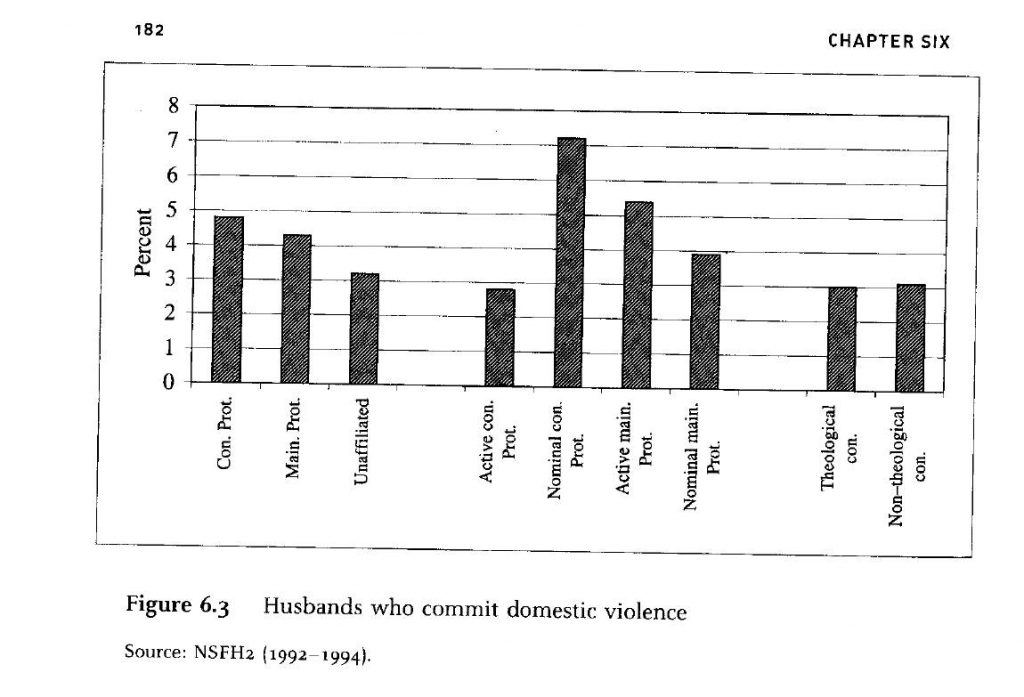How the domestic violence research can help the church
Lets get beyond the culture war
You might have got totally different impressions of how the church responds to domestic violence depending on your media choices this week.
On the ABC, journalist Julia Baird presented a number of reports (here, here and here), that emphasised a statistic – that US research shows that “sporadic” attenders of churches are more likely to engage in domestic violence than the general community. Then News Corp’s Andrew Bolt in the Herald Sun and on Sky News pointed to a key finding from the same research which shows that regular attenders at church are much less likely to be involved in domestic violence. (Karl Faase in Eternity had reported that good news story back in 2015.) To be fair, Baird also reported that statistic but much less prominently.
Baird’s reports contained moving personal stories from victims of terrible abuse at the hands of pastors in mainstream churches. Then on Sunday night Channel Nine’s 60 Minutes reported on shocking abuse within a fringe independent Baptist church (unrelated to the Australian Baptist Ministries or Reformed Baptist networks). The Ninja Warrior field ratings would have made that the report with by far the most reach.
Responding to these reports has been difficult for many Christians who have wanted to balance, on the one hand, correcting an impression left in the ABC report that conservative churches in particular were unsafe, with respect for the women whose stories were told on the other. (Baird does not draw a direct link in these latest reports, but Melbourne Anglican activist Muriel Porter does in the 7.30 version.)
When one blogger posted that we must keep a focus on the victims, what followed was a long list of responses about the media. Epic fail.
There has been a danger that there might be more social media responses attacking the ABC than responding to the real problem of domestic violence among churchgoers, whatever the percentage. For example, when one blogger posted that we must keep a focus on the victims, what followed was a long list of responses about the media. Epic fail.
This then is one of those stories that tells you to read something else. Please read Barbara Robert’s story of her abuse and what she wished she had been told back then, or go to Fixing Her Eyes or A Cry For Justice websites. These show what must be said on this subject.
What follows is a “nice to have” at best.
Here are five signs that you might watch out for in couples who attend your church. This list is not exhaustive, but it may alert you to a potentially concerning situation. Eternity has got these from reading the research this debate has been based on.
- Moderate attenders who attend church for social reasons.
- Men who are infrequent attenders, uninfluenced by positive role models of masculinity, and are cut off from Christian community.
- When men attend church much more often than their wives.
- When a husband has a much more conservative theological view than his wife.
- Where husbands are disengaged from community life.
Here is Eternity’s notes on some of the key research:
Baird links to two papers by Stephen Tracey who is a recognised Christian researcher on this topic.
“What does submit in everything really mean? The nature and scope of marital submission” in Trinity Journal (Trinj) 29. This 2008 Tracy article is about the theology of marriage and links in turn to his 2007 paper, “Patriarchy and domestic violence; challenging common assumptions,” published in the Journal of the Evangelical Theological Society (JETS) 50/3 September 2007.
An insightful quote from Tracy (2007) that makes it clear he is not taking pot-shots at conservative religion makes the point that while a feminist analysis might suggest a relationship between conservative protestant theology and domestic abuse, the data suggests an inverse relationship. “We might surmise from the fact that conservative Protestant men who are regular church attendees have the lowest spouse abuse rates that (1) regular exposure to balanced biblical teaching and preaching on family life detoxifies abusive misbeliefs about male headship; (2) Christian community offers salutary models of loving, non-dominating masculinity; (3) the experience of Christian Community increases men’s sense of confidence and masculinity which in turn decreases their need to control women and children” (page 583-4).
He goes on, however, to note, “What is it about periodic attendance at conservative churches that makes men more likely to abuse their wives, even more likely than non-church goers? For men who are significantly insecure, immature and/or misogynistic, patriarchal teaching of any form may merely serve to confirm their views of male superiority and their right to dominate women” (page 584).
So what is the basis for Tracy’s analysis? He footnotes four North American studies, and one New Zealand one which seems to paint a different picture.
Christopher G. Ellison and Kristin’s L. Anderson ‘s “Religious Involvement and Domestic Violence among US couples,” Journal for the Scientific Study of Religion (2001).
This study used the National Survey of families and Households which had a sample size of 13,017 men and women aged 18 and up. They found that regular religious attendance is inversely associated with domestic violence, but that this protective effect is evident only among weekly attenders. However, this survey did not find the protective effect of weekly attendance varied with denomination, which the authors sorted into Conservative, Liberal, moderate Protestant, Catholic, or none. (Abstract and download here)
Merlin B. Brinkerhoff, Elaine Grandin and Eugen Lupri, “Religious involvement and Spousal violence: the Canadian case,” Journal for the Scientific Study of Religion (1991).
This study used a 1987 national survey of Canada with a sample size of 1,834 people over 18.
“Conservative Christian men do not abuse their partners significantly more often than do affiliates of other denominations. Religious denomination was not found to be significantly related to spousal abuse” (page 15).
The Canadian study also found that moderate church attenders “were highly abusive; the literature suggests that they are the extrinsically committed whose religious activities is motivated by social rather than religious reasons” (page 28).
“The good news is that strong beliefs in religious patriarchy do not appear to generate spousal abuse. The bad news is that religious activity particularly among the moderate attenders, does not appear to mitigate such violence more strongly, especially among men” (page 29).
This earlier Ellison-led study also used the National Survey of Families and Households. It also found that conservative religion did not increase DV while more frequent attendance lowered it. It examined the effect of differences in theology within a couple. “Abuse by men appears particularly likely in couples in which (a) the men attend religious services much more often than their wives or partners and (b) the men hold much more conservative beliefs about the inerrancy and authority of the Bible than their partners.”
W. Bradford Wilcox (Professor of Sociology at the University of Virginia), Soft Patriarchs, New Men: How Christianity Shapes Fathers and Husbands. University of Chicago Press, 2004. Available from Koorong
Quotes have been provided through John Dickson. This appears to be the key text behind Julia Baird’s commentary.

“Figure 6.3 displays predicted means of husbands’ domestic violence derived from logistic regression equations, with all the control variables set at the main or mode. This figure indicates that 4.8% of conservative Protestant married men with children committed domestic violence in the year prior to NSFH2 [National Survey of Families and Households 2], compared to 4.3% of mainline Protestant married men with children and 3.2% of unaffiliated married men with children. The differences between the results of these groups, however, are not statistically significant.”
“Once religious affiliation is broken out by church attendance, however, the differences between religious groups become statistically significant. Nominal conservative Protestant husbands have a domestic violence rate of 7.2% and are significantly more abusive than unaffiliated husbands, active Conservative Protestant husbands, and nominal mainline Protestant husbands. By contrast, active conservative Protestant husbands are significantly less likely to commit domestic violence compared to active mainline Protestant husbands as well as nominal conservative Protestant husbands. Thus, figure 6.3 depicts a surprising phenomenon: namely, that active conservative Protestant husbands are the group in this study least likely to commit domestic violence, and nominal conservative Protestant husbands are the group in this study most likely to commit domestic violence.”
“In turn, the high levels of physical abuse found among nominal conservative Protestant husbands may be a consequence of a lingering commitment to patriarchy that is not tempered by church participation. Or it may be related to social factors that my models cannot adequately address — for example, most nominal conservative Protestants hail from the working class. In any case, we have already seen that nominal conservative Protestant family men devote comparatively little effort to parenting and showing appreciation for their wives’ household labour and that active conservative Protestant family men devote comparatively high levels of effort to the same, and here we have yet more evidence that nominal and active conservative Protestant men differ to a great degree when it comes to their approach to family life.”
Tracey also footnotes a 1986 NZ study by David M Fergusson et al (he is professor of Psychology at the University of Otago, NZ). “Factors associated with Reports of Wife assault in New Zealand”. He includes these figures which appear to be a counter factual to his main idea. ”11.2% of husbands who never attended church at least monthly assaulted their wives, while 6.2 of husbands who attended church sporadically assaulted their wives. This study had a sample size of 960. (Abstract and download here)





